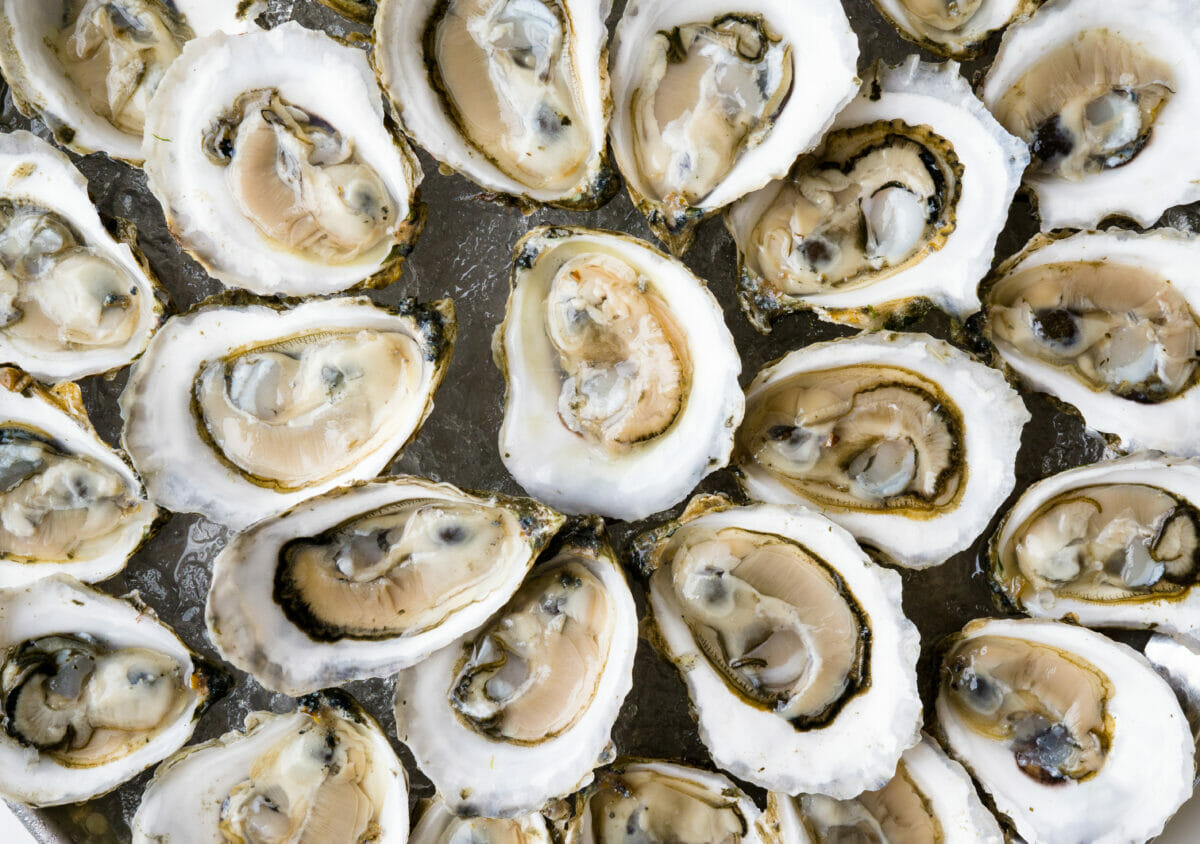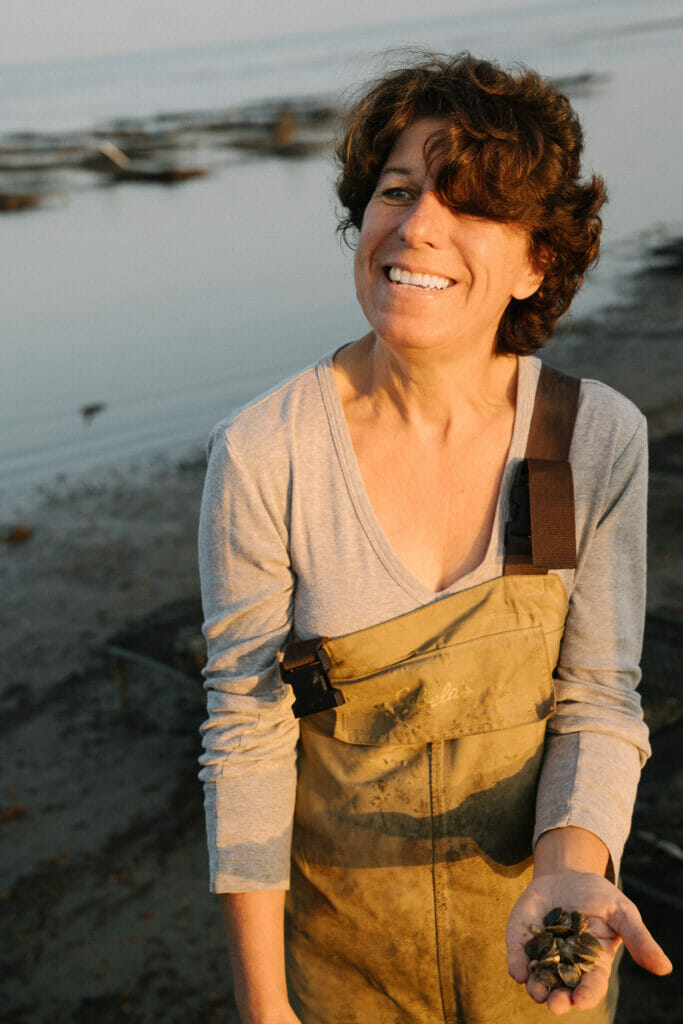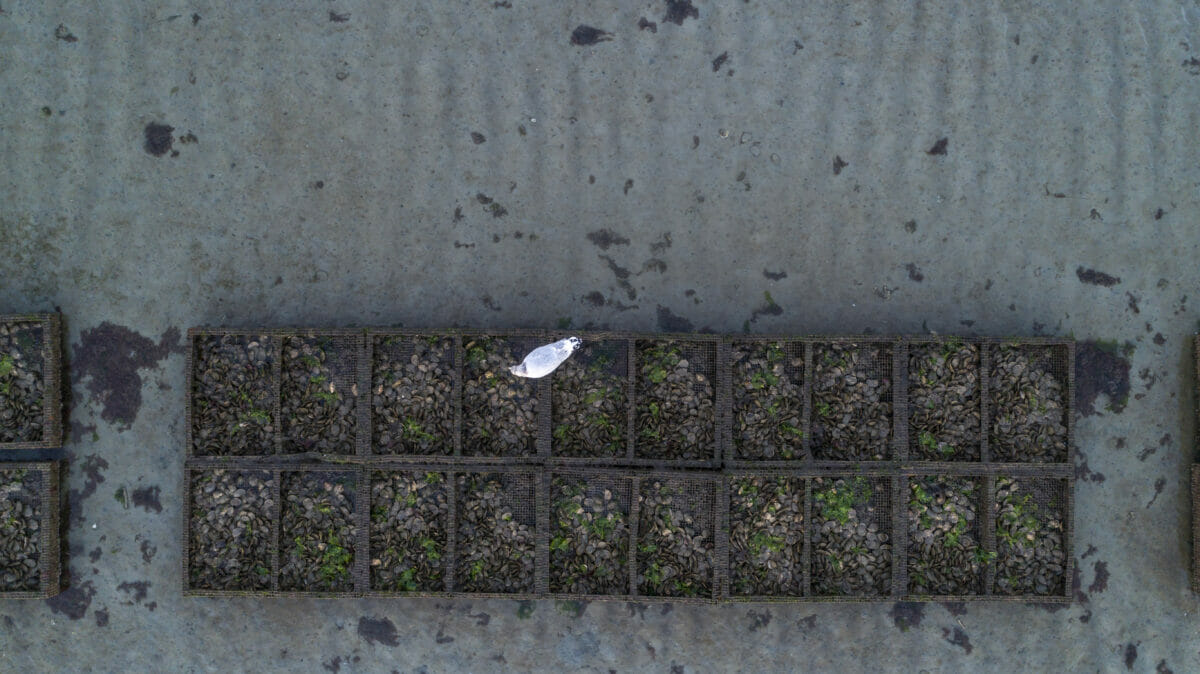The Great Oyster Thanksgiving
Amid a surge in demand, oyster farmers are excited to see the bivalve reclaim a place at the holiday dinner table.
The Great Oyster Thanksgiving
Amid a surge in demand, oyster farmers are excited to see the bivalve reclaim a place at the holiday dinner table.

The oyster industry is making a comeback after enduring the rough waters caused by 2020 shutdowns.by Melissa DiPalma, courtesy of Island Creek Oysters.
There’s a recognizable brininess to an East Coast oyster’s crisp, buttery meat. Lisa Calvo knows it well. She’s spent nearly a decade raising oysters along the sweeping tides of the Cape May Peninsula for local chefs and foodies. Generally, that customer base has grown gradually and organically. But this past year, the owner of New Jersey’s Sweet Amalia Oyster Farm says she’s seen an emergence of enthusiasm for the bivalve as gatherings have become commonplace again.
“With everyone having been at home, inspired to get closer to good food and share it with others, it’s like everyone’s turned onto oysters now,” she says. “It’s like we’re on the cusp of a renaissance, but I’m wishing I had several more thousand oysters to sell before now and Christmas… Demand is outpacing production.”
Calvo, who produces roughly 200,000 oysters each year, says she’s experienced a 50-percent increase in her direct-to-consumer and restaurant sales compared to this time last year. Since then, COVID-19 vaccines have been made available, and Thanksgiving celebrations are resuming after last year’s pandemic restrictions have lifted. To celebrate, many customers have already placed orders for bags of 100 oysters. And with a number of restaurants featuring oysters on their holiday menus, she expects a quick sell-out in the coming days.
Calvo, however, isn’t unique in her experience. Oyster farmers lining the country’s coasts say that, since this summer, the demand for oysters has been higher than usual. It’s a welcome change from the 2020 market, when shuttered raw bars and restaurants left the oyster industry reeling.

While experts in food and agriculture agree that the oyster has long been present in American food culture—including as an important ingredient in the oyster dressing recipe brought over by British colonists that settled in America—the Thanksgiving season presents a unique time to revive tradition. The occasion, they say, is an opportunity to ignite interest around the oyster as a local taste that has the ability to connect and strengthen bonds.
Paul Freedman, a history professor at Yale University and author of American Cuisine and How It Got This Way, writes about the oyster as a staple throughout history. He says its popularity and the demand for it has been in flux based on the environmental conditions of local waters and harvesting practices. What has made the oyster quintessentially American, however, is its ability to become a food source for different populations throughout history.
“Most foods tend to be either upper class or lower class,” says Freedman. “Oysters are an interesting thing… In the 19th century, they were sold all over the East Coast and West Coast and on the street for quite cheap, but at the same time they’ve also been highly prized by the upper classes as a luxury taste.”
Acknowledging the number of oyster farms popping up and the recent enthusiasm that’s ensued, Freedman says it speaks to the food’s legacy. But it’s also possible, he adds, that the oyster is starting to take up a larger space in regional and coastal identities, breathing new life into the locavore movement.

It’s a trend that Chris Sherman, president of Island Creek Oysters, says has already started to materialize at the heart of consumer attitudes. Like Calvo, he’s seeing the surge in demand, and the Massachusetts oyster farm is projecting a 20-to-30-percent increase in direct-to-consumer sales that span across all 48 states. But more than having a stake in the locavore movement, Sherman believes oysters provide an added sense of community, which has largely been absent from people’s lives during the most isolating days of the pandemic.
“Oysters are a food that, on a basic level, really has this unique ability to bring people together in a way that few other foods do,” he says, adding that it makes a lot of sense to have them this Thanksgiving. “They were always a share plate before share plates were even a thing, so I think there’s really a basic human element to that.”
Sherman acknowledges additional factors about the oyster that ground it in a sense of community. For example, he says, those who purchase oysters know they are supporting an industry that purifies coastal environments. It’s also a way to ensure that dollars stay within the regional economy.
Rowan Jacobsen, author of the The Essential Oyster, has written extensively on the American oyster landscape, providing readers with an in-depth guide to the denizens of the sea. Like Sherman, he believes oysters are at the foundation of the locavore movement, but he also referenced the food’s essential role in fueling economies on the Atlantic, Gulf and Pacific coasts for much of history.
“Generations of watermen have worked oysters in America and continue to do so. They are one of the important ways we stay connected to our coasts,” says Jacobsen, who acknowledges that oysters have played a role in inspiring people to become more interested about the food and flavors in their region. If the trend continues to grow, he says, it will only further strengthen these communities.
Whether or not the oyster renaissance is here to stay is not entirely clear. Oyster farmers like Calvo and Sherman are optimistic they’ll continue to build relationships across their customer base and experience steady growth. Because to them, the spike in demand goes beyond a desire for a luxury item; at the center of it all is a yearning to connect with others over good food around the table but also a shared interest in the environment, local food systems and a staple that has long been a part of the national culinary identity.
Follow us
This work is licensed under a Creative Commons Attribution-NoDerivatives 4.0 International License.
Want to republish a Modern Farmer story?
We are happy for Modern Farmer stories to be shared, and encourage you to republish our articles for your audience. When doing so, we ask that you follow these guidelines:
Please credit us and our writers
For the author byline, please use “Author Name, Modern Farmer.” At the top of our stories, if on the web, please include this text and link: “This story was originally published by Modern Farmer.”
Please make sure to include a link back to either our home page or the article URL.
At the bottom of the story, please include the following text:
“Modern Farmer is a nonprofit initiative dedicated to raising awareness and catalyzing action at the intersection of food, agriculture, and society. Read more at <link>Modern Farmer</link>.”
Use our widget
We’d like to be able to track our stories, so we ask that if you republish our content, you do so using our widget (located on the left hand side of the article). The HTML code has a built-in tracker that tells us the data and domain where the story was published, as well as view counts.
Check the image requirements
It’s your responsibility to confirm you're licensed to republish images in our articles. Some images, such as those from commercial providers, don't allow their images to be republished without permission or payment. Copyright terms are generally listed in the image caption and attribution. You are welcome to omit our images or substitute with your own. Charts and interactive graphics follow the same rules.
Don’t change too much. Or, ask us first.
Articles must be republished in their entirety. It’s okay to change references to time (“today” to “yesterday”) or location (“Iowa City, IA” to “here”). But please keep everything else the same.
If you feel strongly that a more material edit needs to be made, get in touch with us at [email protected]. We’re happy to discuss it with the original author, but we must have prior approval for changes before publication.
Special cases
Extracts. You may run the first few lines or paragraphs of the article and then say: “Read the full article at Modern Farmer” with a link back to the original article.
Quotes. You may quote authors provided you include a link back to the article URL.
Translations. These require writer approval. To inquire about translation of a Modern Farmer article, contact us at [email protected]
Signed consent / copyright release forms. These are not required, provided you are following these guidelines.
Print. Articles can be republished in print under these same rules, with the exception that you do not need to include the links.
Tag us
When sharing the story on social media, please tag us using the following: - Twitter (@ModFarm) - Facebook (@ModernFarmerMedia) - Instagram (@modfarm)
Use our content respectfully
Modern Farmer is a nonprofit and as such we share our content for free and in good faith in order to reach new audiences. Respectfully,
No selling ads against our stories. It’s okay to put our stories on pages with ads.
Don’t republish our material wholesale, or automatically; you need to select stories to be republished individually.
You have no rights to sell, license, syndicate, or otherwise represent yourself as the authorized owner of our material to any third parties. This means that you cannot actively publish or submit our work for syndication to third party platforms or apps like Apple News or Google News. We understand that publishers cannot fully control when certain third parties automatically summarize or crawl content from publishers’ own sites.
Keep in touch
We want to hear from you if you love Modern Farmer content, have a collaboration idea, or anything else to share. As a nonprofit outlet, we work in service of our community and are always open to comments, feedback, and ideas. Contact us at [email protected].by Lindsay Campbell, Modern Farmer
November 22, 2021
Modern Farmer Weekly
Solutions Hub
Innovations, ideas and inspiration. Actionable solutions for a resilient food system.
ExploreExplore other topics
Share With Us
We want to hear from Modern Farmer readers who have thoughtful commentary, actionable solutions, or helpful ideas to share.
SubmitNecessary cookies are absolutely essential for the website to function properly. This category only includes cookies that ensures basic functionalities and security features of the website. These cookies do not store any personal information.
Any cookies that may not be particularly necessary for the website to function and are used specifically to collect user personal data via analytics, ads, other embedded contents are termed as non-necessary cookies.
Onward and upward. Hope production continues to increase so more can enjoy the oysters.